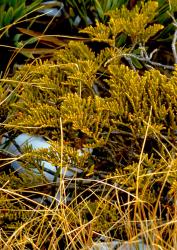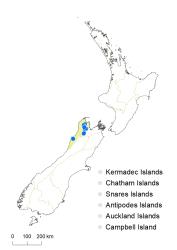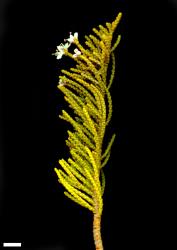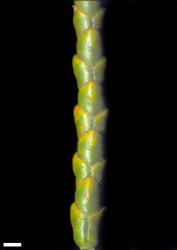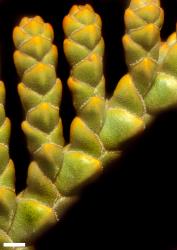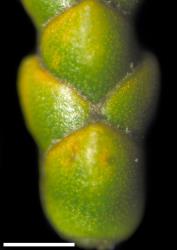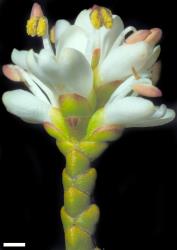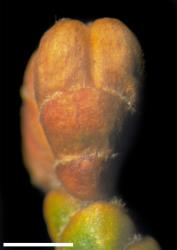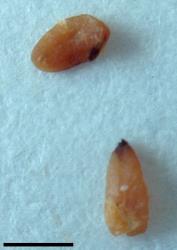- Taxon
- Gallery
- ≡ Hebe ochracea Ashwin in Allan, Fl. New Zealand 1, 936 (1961)
- ≡ Leonohebe ochracea (Ashwin) Heads, Bot. Soc. Otago Newsl. 5: 7 (1987)
Spreading low or bushy whipcord shrub to 0.45 m tall. Stems ascending or spreading, with short, erect secondary branches increasing in length away from main stem apex, eglandular-pubescent; hairs bifarious above leaf axils and usually in the deep groove between the connate leaf bases. Leaf bud indistinct, its outer leaves fully grown, diverging. Leaves opposite-decussate, appressed but not usually covering the obscure node above, crowded and overlapping, coriaceous, broadly ovate to rhomboid, 1.0–1.5 mm long, 1.5–3.0 mm wide, glossy yellow- to bronze-green above and beneath; veins not evident; surfaces glabrous; margin shortly ciliate or ciliolate, entire; apex obtuse; base broad, connate in pairs and encircling stem; petiole absent. Inflorescence a terminal spike, 2.0–8.5 mm long; flowers crowded, 4–8, all bisexual; bracts opposite-decussate and connate, broadly ovate; pedicels absent. Calyx lobes 4, seemingly 3 because anterior pair fused to apex, obtuse to sub-acute, 1.5–2.3 mm long, unequal, eglandular-ciliate with a few short glandular hairs as well. Corolla 4.5–7.5 mm diameter; tube white, 1.0–1.5 mm long, ≤ calyx, eglandular-hairy inside; lobes 4, white, sub-erect to spreading, unequal, elliptic to oblong, 3–4 mm long, obtuse to rounded; nectar guides absent. Stamen filaments white, 3.5–4.5 mm long; anthers pink or yellowish-pink. Style glabrous or a few bristles at base, 3–4 mm long. Capsules latiseptate, obtuse, glabrous or a few bristles especially along suture and at apex, 2.2–3.3 mm long, 1.7–2.2 mm at widest point. Seeds ellipsoid to obovoid, flattened, smooth, pale brown, 1.2–1.5 mm long.
Plants of V. ochracea and three other whipcord hebes, V. annulata, V. armstrongii, and V. salicornioides, all share fused anterior calyx lobes and exposed but generally obscure nodal joint. They all have allopatric distributions, with V. ochracea being confined to north-west Nelson and northern Westland. V. ochracea differs from all of them in its unusual chromosome number. Distinguishing morphological characters are relatively indistinct and subjective, the best being the yellowish- to bronze-green of the foliage in V. ochracea. The leaves are not as closely appressed as those of V. salicornioides and internodes are generally a little shorter. In dried specimens the leaves spread a little from the stem, but not as much as in plants of V. annulata and V. armstrongii.
South Island: Western Nelson (Anatoki Range, Cobb Valley and Peel Range, Mt Arthur Range, Owen Range), Mt Buckland, Paparoa Range.
Sub-alpine grassland and scrub, usually on calcareous substrates. Recorded elevations range from 915 to 1800 m.
Flowers: November–February; fruits: February–April, persisting longer.
2n = 124 (see Bayly & Kellow 2006, as Hebe ochracea).
Veronica ochracea is classified in V. subg. Pseudoveronica sect. Hebe and informally in the “Flagriformes” group, also known as “whipcord hebes” (Albach & Meudt 2010; Bayly & Kellow 2006).
The sexual system needs to be checked in wild populations of V. ochracea. Some herbarium specimens (e.g., WELT 17567, 17481, 17563) seem to have small flowers and pollen was not seen in their dehisced anthers. Others have large flowers with copious pollen (e.g., WELT 82795).
Bayly and Kellow did not record seed characters, and the seed description above is based on only one specimen (WELT SP090750, Lake Peel, Sneddon). Seeds might be more variable than suggested here.
Morphology and chromosome numbers indicate a relationship with V. annulata, V. armstrongii, and V. salicornioides. Its unusual and high chromosome number suggests the possibility of a hybrid origin involving a species with 2n = 40, such as V. hectorii, and one with 2n = 84, such as V. armstrongii. However, V. armstrongii and V. ochracea are geographically separated.
Cultivars
V. ochracea is common in cultivation as hebe ‘James Stirling’. The cv is said to be a dwarf form but otherwise no different from wild plants.



